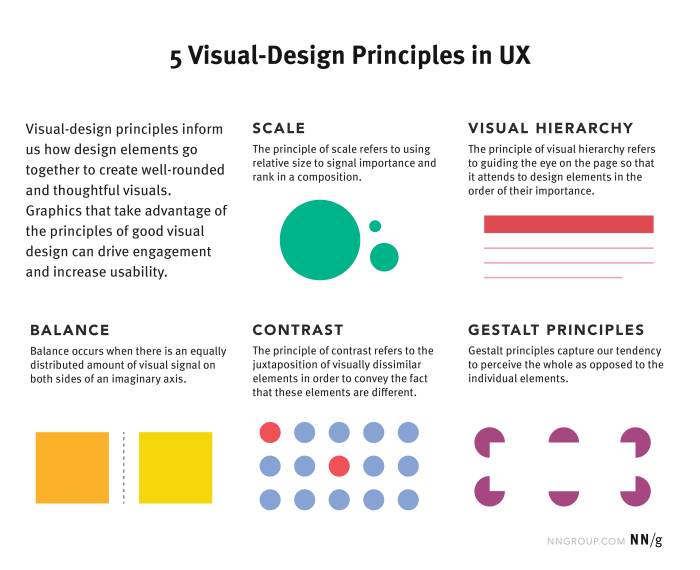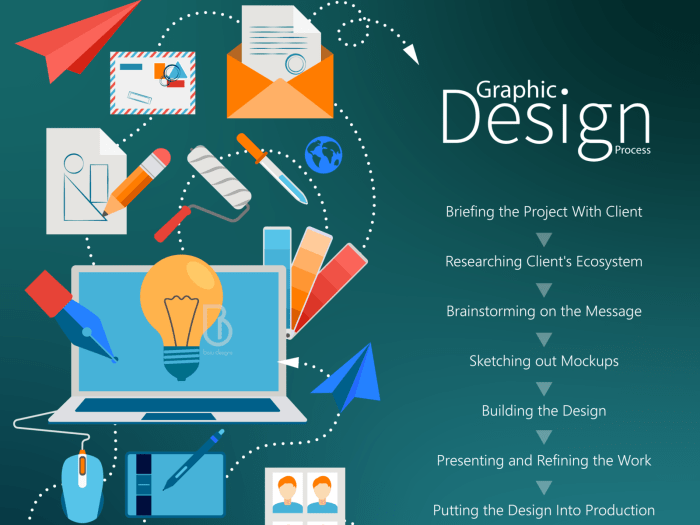Designing Visual Content sets the stage for creating captivating graphics that leave a lasting impression, combining creativity and strategy to engage audiences on a whole new level.
From the importance of visuals to the elements that make them effective, this topic delves into the art and science of designing visual content that speaks volumes.
Importance of Visual Content in Design: Designing Visual Content
Visual content plays a crucial role in design by capturing the audience’s attention, conveying information effectively, and enhancing the overall user experience. In a world where attention spans are short, visual content helps to break down complex ideas into digestible pieces, making it easier for users to understand and engage with the content.
Enhancing User Experience
Visual content such as images, infographics, and videos can create a more immersive and interactive experience for users. For example, a website with high-quality images and engaging videos can keep visitors on the site longer, reducing bounce rates and increasing engagement. Visual content also helps users to quickly scan and navigate through information, leading to a more enjoyable browsing experience.
Impact on Brand Recognition
Consistent and visually appealing content helps to establish brand identity and recognition. Through the use of logos, colors, and fonts, visual content can communicate the brand’s values and personality to the audience. For instance, a well-designed logo can instantly evoke brand recognition and loyalty among consumers. Visual content also aids in creating a cohesive brand image across different platforms, reinforcing brand awareness and recall.
Elements of Effective Visual Content

Visual content is crucial in capturing and retaining the audience’s attention. To make visual content truly effective, several key elements must be considered. These elements include color schemes, typography, layout, imagery, and consistency. Among these, color schemes and typography play a significant role in creating impactful visual content.
Role of Color Schemes
Color schemes are essential in visual content as they evoke emotions, convey messages, and create a cohesive look. The choice of colors can greatly impact the overall feel of the design. For example, warm colors like red and orange can create a sense of urgency or excitement, while cool colors like blue and green can evoke calmness and trust. It is important to choose colors that complement each other and align with the brand’s identity to ensure a visually appealing and effective design.
Importance of Typography
Typography is another crucial element in visual design that can greatly influence how the content is perceived. The choice of fonts, font sizes, spacing, and alignment can impact readability, hierarchy, and overall aesthetics. Different fonts can convey different tones and emotions, so it is important to choose typography that aligns with the message being communicated. Additionally, using consistent typography throughout the design can help create a cohesive and professional look.
Tips for Designing Engaging Visual Content
When it comes to creating visually appealing graphics, there are a few key techniques that can help make your content stand out. One important aspect to consider is the use of whitespace in your design. Whitespace, or negative space, can help create a sense of balance and clarity in your visuals. It allows the important elements of your design to stand out and prevents the overall layout from feeling cluttered.
Utilizing Whitespace Effectively, Designing Visual Content
Utilizing whitespace effectively involves strategically placing elements in your design to create a visually pleasing composition. By giving your content room to breathe, you can draw the viewer’s eye to the most important parts of your design. This can help improve readability and overall impact.
- Avoid overcrowding your design with too many elements. Give each element space to shine.
- Use whitespace to create a sense of hierarchy in your design. By varying the amount of space around different elements, you can guide the viewer’s eye through the content.
- Experiment with different layouts and spacing to find the right balance for your design.
Examples of Successful Visual Content Campaigns
One example of a successful visual content campaign is Nike’s “Just Do It” campaign. The use of bold typography, striking imagery, and a simple color palette helped create a memorable and impactful campaign. The message was clear and the visuals were engaging, making it a successful marketing effort.
Another example is Apple’s product launch events. Apple consistently creates visually stunning presentations that generate buzz and excitement among consumers. The use of sleek design, high-quality images, and innovative animations make their events stand out in a crowded market.
By following these tips and studying successful visual content campaigns, you can improve your own design skills and create engaging visuals that resonate with your audience.
Tools and Software for Designing Visual Content

When it comes to creating visual content, having the right tools and software can make a huge difference in the quality of your designs. Here are some popular design tools used for creating visual content:
Graphic Design Software
- Adobe Photoshop: Known for its powerful editing capabilities and versatility.
- Adobe Illustrator: Ideal for creating vector graphics and illustrations.
- Canva: A user-friendly platform with a wide range of templates and design elements.
- Sketch: Popular among UI/UX designers for its focus on digital design.
Benefits of Using Templates
Using templates in visual content creation can help streamline the design process and ensure consistency in your branding. Some benefits include:
- Save time by starting with pre-made layouts.
- Maintain a cohesive look and feel across all your designs.
- Easily customize templates to fit your specific needs.
- Access a wide variety of design styles to choose from.